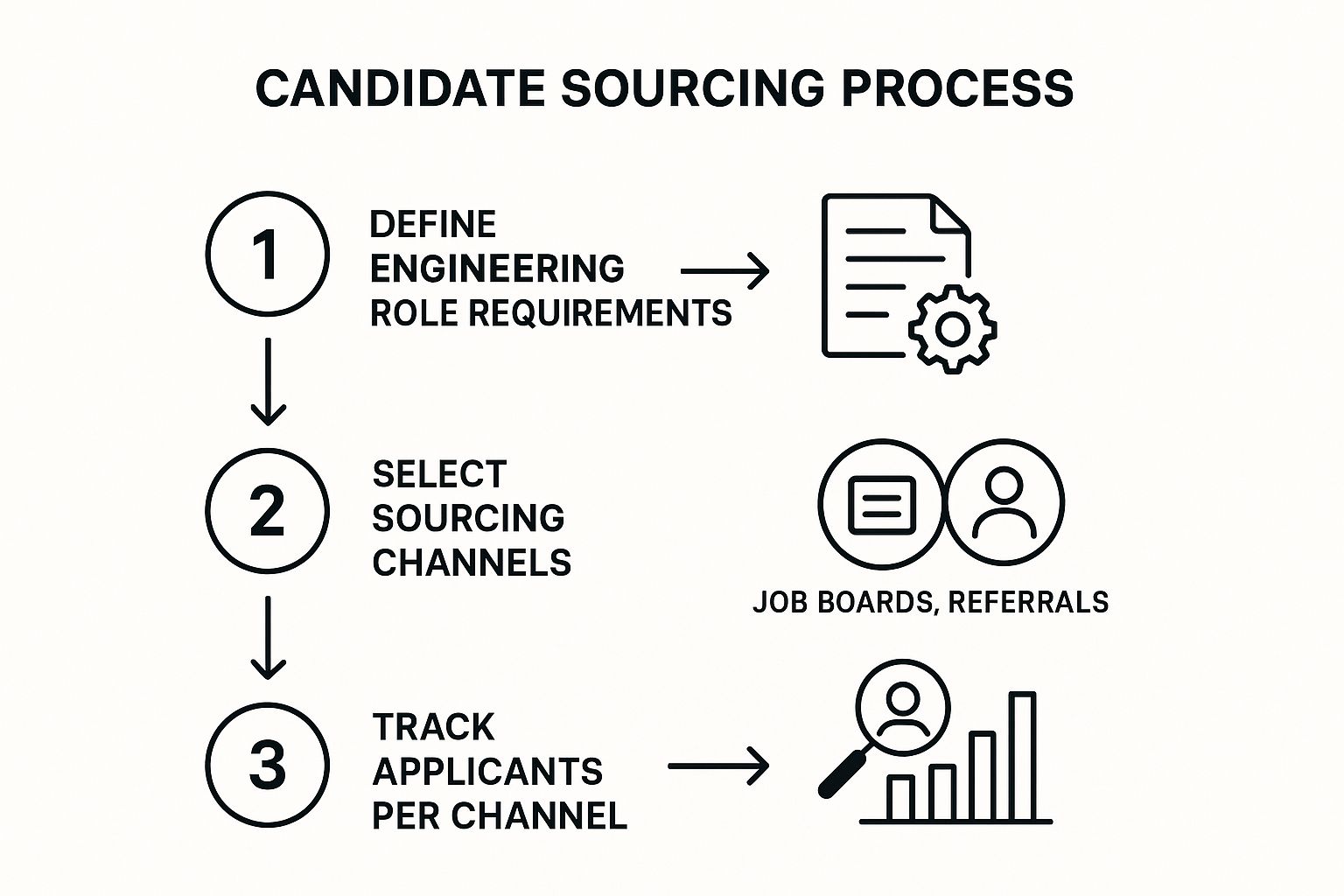August 15, 2025
Mastering Recruitment for Engineering in a Tough Market

Hiring engineers has become a high-stakes, competitive sport. The old "post and pray" method of putting up a job description and waiting for the right people to apply is officially dead. In today's market, where demand for specialized talent dramatically outpaces supply, success requires a whole new game plan—one built on understanding what top engineers actually want and creating a process that respects their skills and their time.
Why Is Engineering Recruitment So Difficult Today?

If finding great engineers feels like searching for a needle in a haystack, it’s because the haystack is now global and the best needles get to choose their own magnets. The entire talent marketplace has flipped. Today, engineers are the discerning shoppers with countless options, while companies are all competing for prime shelf space.
This power shift is driven by a few core challenges that have completely changed the game. The sheer intensity of competition is a huge factor. You’re no longer just up against your direct industry rivals; you’re competing with tech giants, nimble startups, and even non-tech companies building out their own engineering teams. Everyone wants a piece of the same limited talent pool.
The Great Skills Shift
On top of the fierce competition, the very definition of a "qualified" engineer has changed. The old emphasis on prestigious university degrees and academic credentials has been pushed aside by a much more practical priority: demonstrated skills. This is a massive departure from old-school hiring, and it’s been driven by the rise of bootcamps, online courses, and a culture that values what you can build over where you went to school.
Companies are now looking for real-world competence and impressive project portfolios, especially in fast-moving fields like software development and data engineering. Your recruitment for engineering strategy has to adapt to this reality, finding new ways to identify and truly validate these hands-on abilities. You can explore more about these evolving hiring patterns to see what they mean for the future.
The core issue isn't just a talent gap anymore; it's a strategy gap. Companies clinging to outdated hiring practices are consistently losing out to those who adapt to the new realities of the engineering job market.
Key Shifts in Modern Engineering Recruitment
The way we hire engineers has undergone a fundamental transformation. What worked even a few years ago is now insufficient. The table below breaks down the key differences between the old, traditional playbook and the modern, skills-first approach that winning teams are adopting.
This shift isn't just about tweaking a few steps; it's a complete philosophical change. The modern approach acknowledges that talent, not the company, holds the power, and it designs the entire process around attracting and impressing that talent.
Navigating the New Landscape
This new environment requires a completely different playbook. Success now hinges on moving away from passive recruiting and embracing modern methods that are both efficient for your team and genuinely engaging for candidates. This involves a smart blend of:
- Proactive Sourcing: Actively seeking out talent where they live online, from open-source projects on GitHub to specialized forums and communities.
- Skill-Centric Assessments: Designing technical evaluations that mirror the actual work they’d be doing, not abstract puzzles.
- Efficient Processes: Using technology to streamline screening and communication, guaranteeing a positive candidate experience from the first touchpoint to the final offer.
Ultimately, winning over the best engineering minds requires you to fundamentally rethink how you approach recruitment. It's about building a system that doesn't just find talent but also impresses them enough to want to join your team.
Diagnosing Your Engineering Hiring Headaches
If you’re caught in a frustrating loop of ghosted candidates, mismatched skills, and screening calls that go nowhere, you’re definitely not alone. These hiring struggles feel personal, but they’re really just symptoms of a broken process. Think of your hiring workflow like an engine—if it’s sputtering along, you need to pop the hood and find out what’s really wrong.
For many teams, the first sign of trouble is drowning in a sea of resumes. You spend countless hours sifting through applications just to find a handful of people who might be qualified. This initial screening phase becomes a massive time sink, pulling everyone away from what they should be doing: building relationships with great engineers.
The Buzzword Mirage
One of the biggest headaches is trying to figure out who has genuine expertise versus who just has a well-polished LinkedIn profile. A resume loaded with the latest frameworks and jargon doesn’t always mean the person can actually solve real-world problems. It's a classic scenario: you spend hours interviewing someone who talks a great game, only to realize they can’t code their way out of a simple problem.
This "buzzword mirage" happens when we lean too heavily on keyword matching and resume scanners. It's a flawed system that values surface-level signals over proven ability, which leads to wasted interview slots and frustration for everyone. The challenge isn't just finding people; it's finding the right people.
The problem is getting worse in today’s hyper-competitive market. According to a report from the American Council of Engineering Companies (ACEC), an average of 9% of engineering positions are sitting empty. With 75% of firms planning to hire more, the fight for talent is only going to get tougher, making every hiring mistake more painful. You can learn more about the current engineering job market shifts and what they mean for your team.
Hidden Costs and Slow Feedback Loops
A bad hire obviously costs money, but the hidden costs are what really sting. The wrong engineer can tank team morale, derail project timelines, and create a drag on productivity. All the time your best people spend fixing mistakes or re-doing work is time they aren't spending building your product.
On top of that, slow internal processes create their own brand of chaos. When it takes days to get feedback from a technical interview or communication with a candidate goes dark, you're sending a clear signal: we’re disorganized, and we don’t respect your time. In a market where top engineers often have multiple offers on the table, a clunky process is a surefire way to lose out.
A slow hiring process is a brand killer. Top engineers interpret inefficiency and poor communication as a reflection of your company's overall engineering culture—and they will opt out before you even get to an offer.
To truly fix your recruitment for engineering, you have to start by identifying these specific pain points. Are you burning too many hours on manual screening? Are your technical assessments actually predicting on-the-job performance? Is your feedback loop so sluggish that your best candidates are long gone by the time you make an offer?
These headaches are usually caused by a few interconnected problems:
- Ineffective Sourcing: Waiting for applications to roll in from job boards instead of actively finding talent where they already hang out online.
- Vague Job Descriptions: Using boring, generic templates that don't sell the real impact of the role, which attracts a lot of unqualified applicants.
- Unstructured Interviews: Winging it with inconsistent questions, making it impossible to compare candidates fairly and opening the door to bias.
- Poor Candidate Experience: Ghosting applicants or failing to communicate clearly at every step, which tanks your reputation and causes people to drop out.
By getting honest about these issues, you can stop putting out fires and start building a hiring machine that’s efficient, fair, and attracts the kind of engineers you actually want to hire.
Building a Modern Engineering Recruitment Workflow
Once you’ve pinpointed the pain points, it’s time to build the cure. A modern engineering recruitment workflow isn't just a checklist; it's a carefully designed system meant to attract, evaluate, and ultimately win over top talent. Think of it less like a rigid assembly line and more like a Formula 1 pit crew—every move is precise, efficient, and geared toward a winning outcome.
Moving from abstract problems to a solid game plan means breaking the process down into clear, actionable stages. This isn't about reinventing the wheel. It’s about fine-tuning each part to respect an engineer's time and intelligence. The goal is a process that top candidates will not only finish but also respect you for.
Writing Job Descriptions That Actually Get Read
The very first touchpoint—the job description—is where so many companies stumble. They churn out a dry shopping list of technologies and qualifications that just doesn't inspire anyone. A great engineering job description should feel like an invitation to solve interesting problems, not just a list of demands.
Start by sitting down with your hiring managers to truly understand the why behind the role. What challenges will this engineer get to tackle? What kind of impact will their work have on the product or the customer? You have to frame the position around contribution and growth, not just day-to-day duties.
- Talk About Impact: Instead of writing, "Must know Python," try something like, "You'll use Python to build the core data pipelines that process millions of user events daily."
- Showcase Your Culture: Give a glimpse into how your engineering team works. Do you champion pair programming, set aside dedicated learning time, or encourage open-source contributions? Say so.
- Keep It Real: Please, don't ask for "10 years of experience" in a technology that's only five years old. It instantly signals that you're out of touch and will deter qualified, diverse candidates.
Strategic Sourcing Beyond the Usual Suspects
Only posting on LinkedIn or job boards is like fishing in a pond where everyone else is using the same bait. Strategic sourcing is about going where the best engineers actually hang out, not just waiting for them to stumble upon your ad. This takes a proactive, multi-channel approach to find both active job seekers and those who aren't even looking.
This workflow shows how to define your needs, pick the right channels, and keep track of candidates effectively.

As you can see, a successful search starts with a crystal-clear role definition before you ever send that first message. This ensures your efforts are laser-focused from day one.
Structuring Multi-Stage Assessments
The assessment stage is where you get to validate a candidate's skills, but it's also the easiest place to lose them. The trick is to design a multi-stage process that tests different skills progressively without becoming a huge time-sink.
A balanced approach often looks something like this:
- Initial Technical Screen: A quick call or an automated coding challenge to make sure the foundational knowledge is there.
- Practical Take-Home Project: A small, clearly defined project that mirrors a real-world task. This should be respectful of their time—think 2-4 hours maximum—and should focus on practical problem-solving.
- Live Technical Interview: This could be anything from a collaborative coding session to a system design discussion. The emphasis should be on their thought process and how they communicate, not just on whether they get the "right" answer.
This layered approach gives you a much more complete picture of a candidate's capabilities. For a deeper look at the strategy behind these stages, it's worth checking out a comprehensive guide to recruiting for engineers that really breaks it all down.
Conducting Meaningful Behavioral Interviews
Technical chops get a candidate in the door, but their behavioral fit is what determines if they'll succeed in the long run. Behavioral interviews are absolutely vital for understanding how an engineer collaborates, handles disagreements, and approaches new challenges. This is where you uncover whether they’ll be a great teammate.
An engineering team's success is as much about collaboration and communication as it is about code. A behavioral interview is your best tool for ensuring a new hire will elevate the team, not disrupt it.
Use structured questions that prompt candidates for specific examples from their past. For instance, instead of asking, "Are you a team player?" ask, "Tell me about a time you had a technical disagreement with a colleague. How did you resolve it?" This gets you real-world behavior, not just rehearsed answers. For more tips on structuring your entire hiring journey, take a look at our guide on how to improve your recruitment process.
When you build a workflow that is efficient, fair, and focused on what truly matters to engineers, your hiring process transforms from a burden into a powerful competitive advantage. This blueprint helps you consistently land high-quality engineers who are genuinely excited to join your team.
Using AI to Your Strategic Advantage

It's time we stopped talking about AI as a job threat and started seeing it for what it is: the most powerful recruiting assistant you've ever had. In the specialized world of recruitment for engineering, AI tools aren’t here to replace the human touch—they’re here to amplify it.
Think of an AI platform as your co-pilot. It expertly handles the repetitive, data-heavy tasks of sourcing and initial screening, which often eat up most of your day. This shift lets you focus on what really matters: building genuine relationships with top candidates, understanding their career ambitions, and showing them why your company is the right place for them.
Moving Beyond Manual Screening
The most immediate win with AI is its sheer speed and scale. A smart tool can analyze hundreds of résumés and online profiles in minutes, a task that would take a human recruiter hours, if not days. And we're not just talking about basic keyword matching here.
Modern AI understands context. It can infer skills from project descriptions on a GitHub profile or identify promising engineers from their contributions to technical forums. This means you can spot incredible passive talent that your competitors, who are only sifting through inbound applications, will completely miss.
AI doesn't just find more candidates; it finds the right candidates, faster. By creating objective, data-driven shortlists, it removes the guesswork that slows down the top of the hiring funnel.
This efficiency boost is a true game-changer. Imagine flipping the script: instead of spending 80% of your time searching, you can invest that energy engaging a pre-vetted pool of high-potential engineers.
Enhancing Objectivity and Fairness
Let’s be honest—unconscious bias is a real challenge in recruiting. It can cause us to unintentionally overlook amazing candidates from different backgrounds. AI brings a much-needed layer of objectivity to the process by focusing strictly on skills, experience, and qualifications.
When an AI platform evaluates a candidate, it doesn't see a name, a school, or a gender. It sees code quality, project complexity, and technical proficiency. Platforms like Klearskill take this a step further by using skills tests that provide standardized, fair comparisons of every single applicant's actual abilities.
This data-first approach helps you build more diverse and innovative teams. It also strengthens your employer brand, as candidates genuinely appreciate a hiring process that feels transparent and merit-based. You can learn more about this in our detailed guide on https://www.klearskill.com/blog-post/ai-for-talent-acquisition.
The table below breaks down exactly how AI tools can upgrade each phase of your hiring process.
AI Impact on Key Recruitment Stages
As you can see, the improvements aren't just minor tweaks; they represent a fundamental shift toward a more efficient and equitable workflow.
The Strategic Impact on Your Workflow
Bringing AI into your recruitment process does more than just save time—it creates a ripple effect of strategic advantages. By accelerating the initial screening stages, you drastically cut down your overall time-to-hire. In a market where top engineers often have multiple offers on the table, speed is everything.
Plus, you can stay ahead of changing market demands. For example, AI-driven tools and growing cybersecurity needs are creating new roles that require a blend of skills. By automating the search, you can more easily pinpoint talent with this unique, multidisciplinary expertise.
Finally, AI helps perfect the candidate experience. Automating communications and scheduling ensures no one falls through the cracks or is left waiting for feedback. To really nail your outreach, you could even use an AI social media content generator tailored for recruitment. This kind of consistent, professional communication builds trust and shows candidates you respect their time—a small detail that leaves a lasting impression.
How to Assess Technical Skills Fairly and Effectively
The technical interview is the heart of engineering hiring, but it’s also where things so often go wrong. For decades, the go-to method has been abstract whiteboard puzzles and algorithmic brain teasers. The problem is, these tests are better at gauging a person's ability to memorize things under pressure than predicting how they’ll actually perform on the job.
This old-school approach has a nasty habit of filtering out brilliant, diverse candidates. Someone might not shine while solving a clever puzzle on the spot, but they could be an absolute rockstar at building real-world software. The goal shouldn't be to ask, "Can they solve this riddle?" It needs to be, "How will they help our team solve our customers' problems?"
Moving Beyond the Whiteboard
Relying on abstract puzzles is like trying to judge a chef by asking them to solve a crossword puzzle about ingredients. Sure, it's related, but it completely misses the point. Whiteboard challenges create a high-stress, artificial bubble that looks nothing like how engineers actually work—collaboratively, with access to tools and documentation.
This approach can also unintentionally favor candidates from certain academic backgrounds or those with the spare time to grind practice problems for months. It often overlooks people with deep, practical experience. This can lead to a less diverse team, as studies have shown these high-pressure scenarios can disproportionately affect underrepresented groups in tech. The world of recruitment for engineering has to move past these outdated gatekeeping tactics.
The best technical assessments feel less like an exam and more like a preview of the job. They give candidates a real chance to show what they can do in a context that reflects your team's day-to-day challenges.
Designing Practical Take-Home Assignments
A well-designed take-home assignment is one of the most powerful tools for seeing a candidate's practical skills in action. The key is to make it a realistic, bite-sized version of a problem your team has actually tackled. This isn't about assigning a week's worth of free labor; it should be a focused task that takes a reasonable amount of time, usually around 2-4 hours.
To keep these assignments fair and get the most out of them, stick to a few ground rules:
- Provide Clear Instructions: Lay out the scope, requirements, and what you'll be looking for right from the start. Ambiguity just adds stress and gives you inconsistent results.
- Focus on the "Why": The goal is to see their thought process, code quality, and practical problem-solving—not to find a single "correct" answer.
- Respect Their Time: A project that eats up an entire weekend is a major red flag for top talent, who are almost certainly juggling other interview processes.
Uncovering Collaboration with Pair Programming
While take-home tasks are great for seeing how someone works alone, pair programming sessions are gold for understanding how a candidate collaborates, communicates, and thinks on their feet. This isn’t about putting them under a microscope. It’s a joint exercise where one of your engineers and the candidate tackle a problem together.
This approach reveals critical soft skills that a solo test just can't. You get to see how they explain their ideas, how they take feedback, and how they contribute to a shared goal. It shifts the dynamic from an interrogation to a conversation, giving both of you a genuine feel for what it would be like to work side-by-side.
Assessing the Big Picture with System Design Interviews
For more senior roles, the system design interview is a must. This is where you zoom out from the code to evaluate a candidate's architectural thinking. You present them with a broad, open-ended problem, like "Design a URL shortening service" or "Architect a basic social media feed."
What you’re looking for isn’t a flawless, finalized diagram. You’re really assessing their ability to:
- Ask smart, clarifying questions to nail down the constraints and requirements.
- Break down a massive, complex problem into smaller, manageable pieces.
- Talk through the trade-offs between different technologies and design choices.
- Communicate their architectural vision clearly and defend their decisions.
This style of interview reveals a candidate's experience and depth in a way no algorithm puzzle ever could. By mixing these modern assessment methods, you build a process that’s fair, effective, and respectful—and one that helps you find truly great engineers.
Building an Employer Brand That Engineers Respect

In a market where skilled engineers have endless options, your employer brand is your most critical asset. A powerful brand isn't about the superficial perks like a ping-pong table or free lunches; it's about building a solid reputation that resonates with what technical minds actually care about.
At their core, engineers are problem-solvers. They're drawn to companies that offer meaty challenges, real opportunities for skill growth, and the autonomy to do their best work. A brand that spotlights these values will always cut through the noise in the competitive world of recruitment for engineering.
Showcasing Your Engineering Culture
Trust is built on authenticity. You can't just tell engineers you have a great culture; you have to show them. This means giving them a genuine look behind the curtain at how your teams collaborate, the tough problems you’re tackling, and the tech you're using to do it.
This kind of transparency is what elevates a standard job description into a compelling career move. It’s a sign of respect for their craft and an acknowledgment that their motivation goes far beyond a salary.
Here are a few practical ways to make your engineering brand tangible:
- Launch a Technical Blog: Let your engineers write about the gnarly problems they've solved, the new tech they're exploring, or the hard-won lessons from a recent project.
- Support Open-Source Contributions: Encourage your team to contribute to open-source projects. This not only sharpens their skills but also signals that your company is an active participant in the wider tech community.
- Host Community Tech Talks: Sponsor or organize meetups where your engineers can share what they know. This is a great way to establish your team members as leaders in their field.
Your employer brand is the sum of every interaction a candidate has with your company. A fair, respectful, and efficient hiring process is one of the most powerful brand statements you can make.
A Brand Built on Fairness and Respect
Ultimately, a strong employer brand is just a reflection of your internal culture and how you treat people during the hiring process. When you commit to a fair assessment, communicate clearly and on time, and genuinely respect every candidate's effort, you earn a reputation that no amount of marketing can buy.
This foundation of respect becomes a self-sustaining engine, attracting the kind of thoughtful, talented engineers you want on your team.
Common Questions About Engineering Recruitment
It’s no surprise that hiring for engineering roles brings up the same questions time and time again. Let’s face it, getting this right is tough. Getting clear, straightforward answers is the only way to build a hiring process that actually works—one that attracts great people and convinces them to stay.
Here are some of the most common sticking points we see hiring managers and recruiters wrestle with.
How Long Should Our Hiring Process Take?
If you're wondering what a "good" timeline looks like, aim for 3 to 5 weeks from the first hello to a signed offer. Any longer than that, and you're rolling the dice.
Your best candidates are almost always talking to other companies. When your process drags on, it doesn't just feel slow; it screams disorganization. This is where AI tools can be a game-changer, automating the tedious screening and scheduling that eats up valuable time. A swift, smooth experience is a huge competitive advantage.
What Is the Biggest Mistake in Technical Interviews?
Hands down, the biggest mistake is leaning on abstract brain teasers or whiteboard coding problems that have zero connection to the actual job. These old-school tactics don't measure a candidate's real-world problem-solving skills. They just test how well someone performs under pressure or memorizes algorithms, which can scare away perfectly capable engineers.
Instead of abstract puzzles, give candidates a taste of the real work. Practical assessments like a small take-home project or a collaborative pair programming session will tell you far more about their technical chops and how they work with a team.
How Can We Reduce Bias in Our Process?
Tackling bias isn't a one-and-done fix; it requires a conscious, multi-layered effort. The goal is to make sure you're evaluating people based on skill, not unconscious assumptions.
- Use Structured Interviews: This is a big one. Ask every single candidate the same questions related to the job, and score their answers using a consistent rubric. No more winging it.
- Implement Blind Reviews: In the early stages, use tools or just a simple process to hide names, schools, and other identifying details from résumés. Let their experience speak for itself.
- Leverage Objective Assessments: This is where skill-based platforms really shine. They evaluate candidates purely on the quality of their code and their ability to solve a problem, taking background and pedigree out of the equation.
It also helps tremendously to assemble a diverse interview panel. Bringing different viewpoints into the room naturally balances out individual biases. For a deeper dive, check out our guide on recruitment best practices.
Ready to make your engineering hiring faster, fairer, and more accurate? Discover how Klearskill uses AI to eliminate bias and identify top talent in seconds. Start hiring smarter today.
